Gibraltar is a tiny little dot of a place, just 2.6 square miles (6.8 square kilometers) in size. Considering its diminutive area, you’d be forgiven for thinking that there couldn’t possibly be much to do the British Overseas Territory, but you’d be wrong.
A geographical and cultural meeting place, its location has seen it play an outsized part in the history of the region. Fought over by Moorish caliphates, Spanish monarchies and British armies, the remnants of its past can still be found dotted all over the headland, from the hardy medieval castle that has survived hundreds of years of bombardment, to siege tunnels that represent an astonishing feat of 18th-century engineering.
Gibraltar’s manmade points of interest are more than matched by the unique natural features that make it such a curiosity. First-time visitors are often surprised by just how impressive the famous Rock is when first confronted by the limestone promontory – almost as surprised as they are to learn that it is home to Europe’s only wild monkey population. The surrounding waters, meanwhile, are filled with not one but three different species of dolphin, which frolic in the sea all year round.
Located in one of the most southern parts of Spain, this bastion of Britishness seems like a complete anomaly in the region, which is just one more reason to set aside a day or two to visit the strange little city.
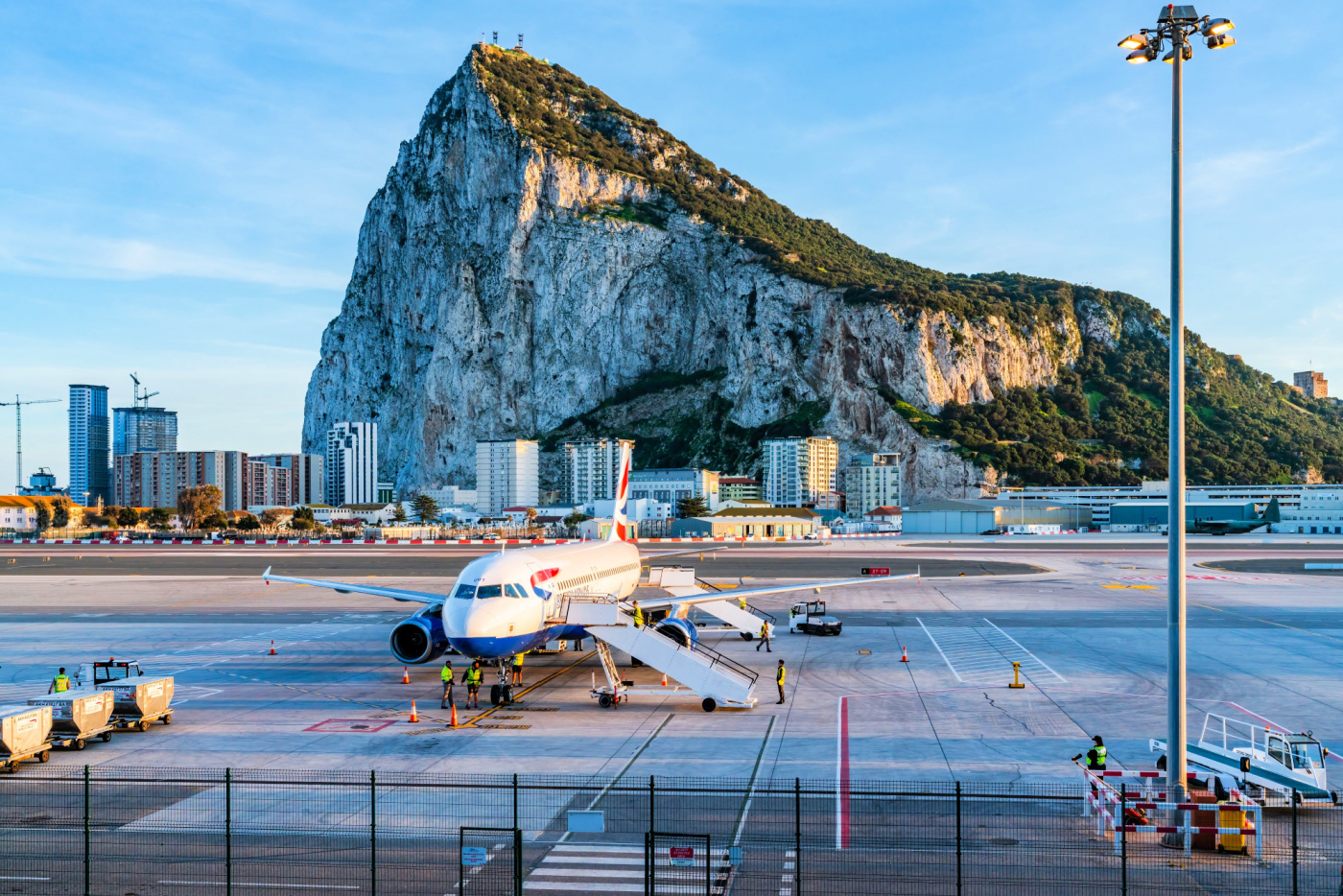
Enter Gibraltar by Crossing the Airport Runway
Taking into account the strict regulations around anything to do with aviation these days, there is something liberating, almost transgressive about casually strolling across the flight path of a plane. That’s something you can do in Gibraltar, however, which has to be one of the few (if not only) places in the world that you enter by crossing a strip of active airplane runway.
The city’s tiny airport only runs flights to a handful of destinations in the UK, including London, Manchester and Edinburgh. Each time a plane lands or takes off, the road from Spain into Gibraltar is closed. As long as you are in no hurry, this makes for a fantastic opportunity to observe aircraft maneuvers up close and personal, in a way that’s uncommonly difficult in other settings.
It’s worth noting here that you can either walk or drive into Gibraltar from Spain, but parking can be tricky in the British Overseas Territory. We would recommend instead leaving your car at one of the options in La Linea del Concepcion, then crossing the border on foot.
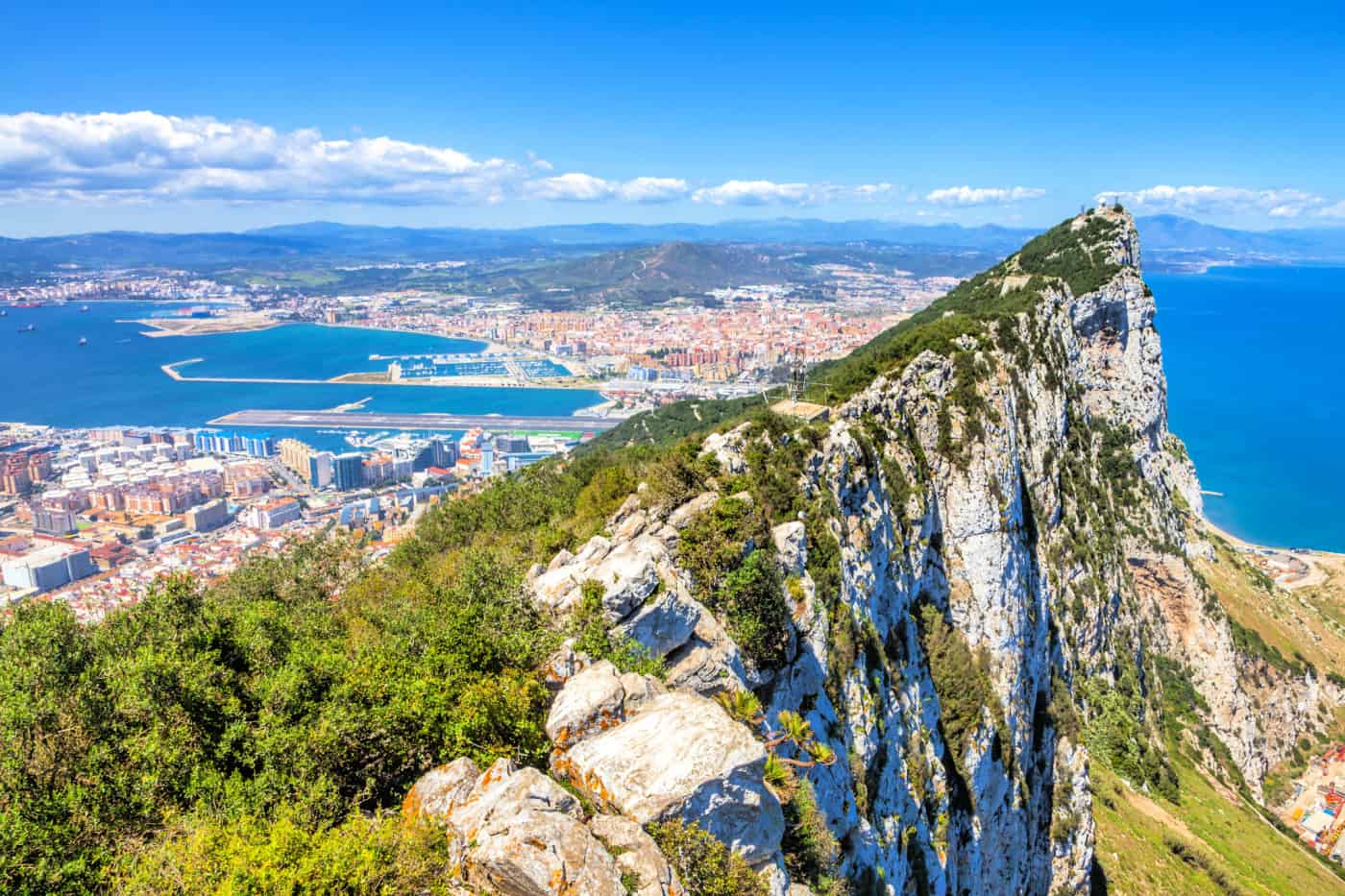
Experience the Majesty of the Rock
Photos cannot do justice to what it’s like seeing the Rock of Gibraltar firsthand. The way the limestone promontory rises out of the flat surrounding landscape is a fantastic oddity. On a clear day, its white rock slopes, covered in a verdant layer of green bushes and trees, undulate against the blue sky in a beautiful mélange of color.
At its highest, the rock is 426 meters, towering above the rest of Gibraltar by some margin. Most of the habitable area of the isthmus lies to its west, while the east is more famous for its sandy beaches – but more on that later.
There are many different views you can have of the Rock, but one of the best comes just after you cross the border. From here, you’re far enough away to see just how extensive the Jurassic Age monolith is. No wonder it was famous to the Ancient Romans, who called it Mons Calpe and referred to it as one of the two Pillars of Hercules. These pillars were once said to mark the boundary of the known world, where the Mediterranean ended and the vast expanse of the Atlantic began.
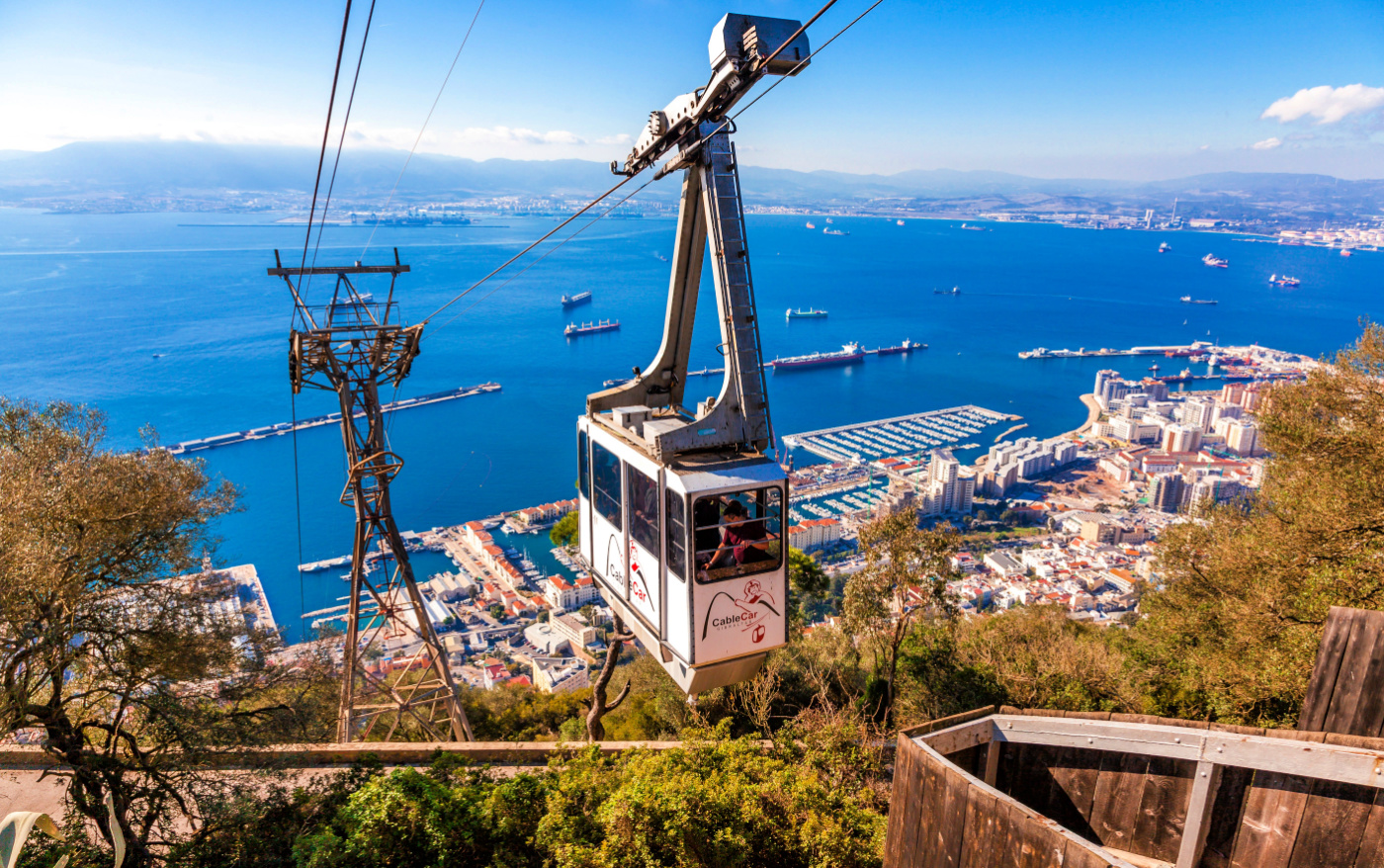
Take the Cable Car
The easiest way to get up to the top of the Rock is via the cable car, which runs seven days a week and departs every 10 to 15 minutes approximately. Originally built in 1966, the line was updated in 1986 but still feels modern and safe almost 40 years later.
It takes just six minutes to ascend the 412 meters from the base station (located at the southern end of Main Street) to the top station. As you rise, there are stunning views of the city’s downtown area and the marina, as well as the lush slopes of the Rock. The top station itself consists of several decks from which you can gaze out onto the surrounding landscape.
The upper climes of the Rock are all part of Gibraltar’s Nature Reserve, which is ticketed. Make sure you pick up your entrance passes at the base station before you board the cable car if you intend to spend some time exploring (which we highly recommend). Tickets for a single on the cable car plus access to the nature reserve were £32 when we last went. Bear in mind that while you can buy vouchers online, these have to be redeemed as tickets once you are on site.
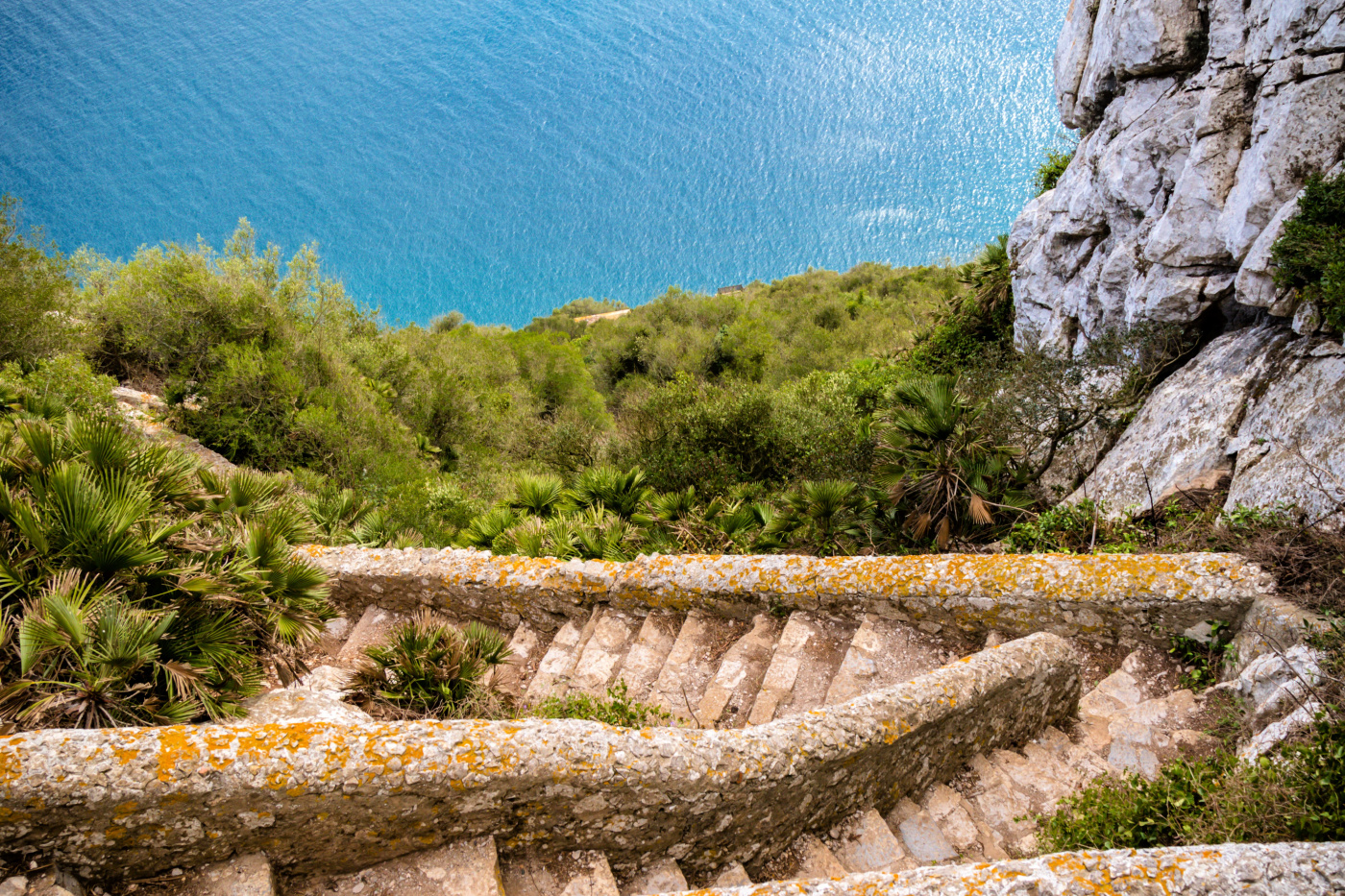
Hike the Mediterranean Steps
If you’re of a reasonable fitness level, you absolutely must hike either up or down the Rock. It takes quite a bit longer than the cable car but gives you more time to savor the views and – perhaps more importantly – provides you with a real sense of accomplishment. As with the cable car, don’t forget to buy your ticket to the Nature Reserve before you begin the ascent!
The route itself is fairly straightforward. Before reaching the scenic Mediterranean Steps that form the main part of the hike, there’s the gentle, 30-minute walk along Europa Road and Engineers Road from the cable car bottom station to the Jews’ Gate Cemetery, which abuts the formal entrance to the Nature Reserve.
Once you’ve passed the monument to the Pillars of Hercules (a rather banal affair considering the millennia-old history), the real work begins. Be warned there are some steep climbs ahead, and in sunny weather it’s sweaty work. Pack plenty of sunscreen and water for your hour-long expedition. Your efforts will be rewarded with incredible view upon incredible view out across the shimmering sapphire sea. Plus, in a pinch you can always slip into one of several natural caves or the remnants of a British military installation to rest in the shade.
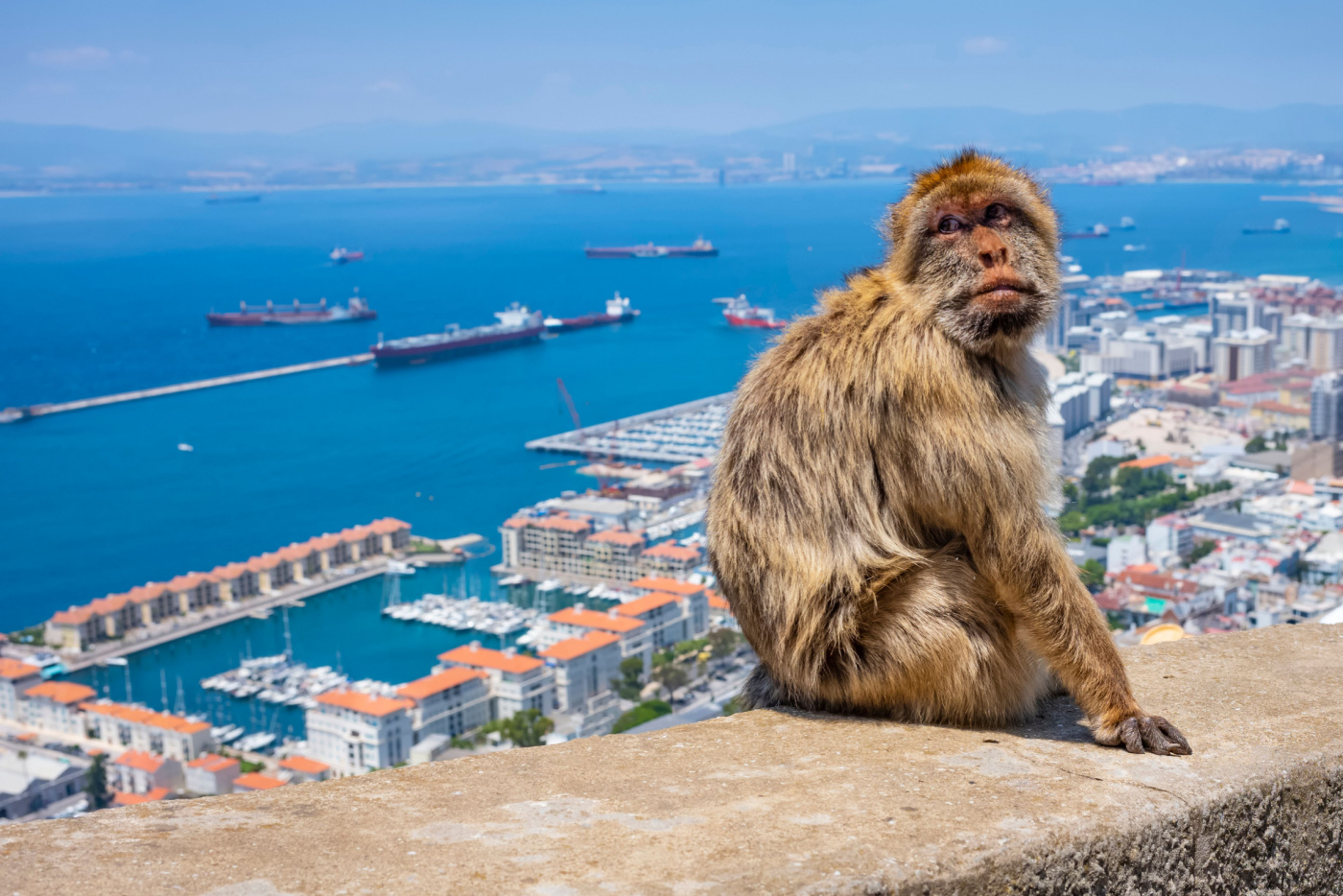
Mug with the Macaques
Gibraltar’s Nature Reserve is home to what is claimed to be Europe’s only wild monkey population, the Barbary macaques. Nobody seems to know how or when these animals first got here, though it’s assumed they were brought over from Morocco. What is known is that they’ve now been residents of Gibraltar for more than 300 years.
While these monkeys might be wild, they are no strangers to human populations. They are delightfully curious creatures, though they can come on aggressive if they think you have food or something intriguing to play with. Avoid putting yourself in an awkward position by giving them plenty of space and keeping a tight grip on your belongings. With those caveats out of the way, they are very cute to watch, and Gibraltar activities don’t come more iconic than snapping a cheeky selfie with the mischievous rogues.
There are estimated to be around 200 macaques currently living on and around the Rock, so you’re almost guaranteed to see them in the Nature Reserve. Local lore has it that as long as the monkeys remain in Gibraltar, the British will reign there – perhaps one of the reasons Winston Churchill elected to bulk up the population during his tenure as prime minister.
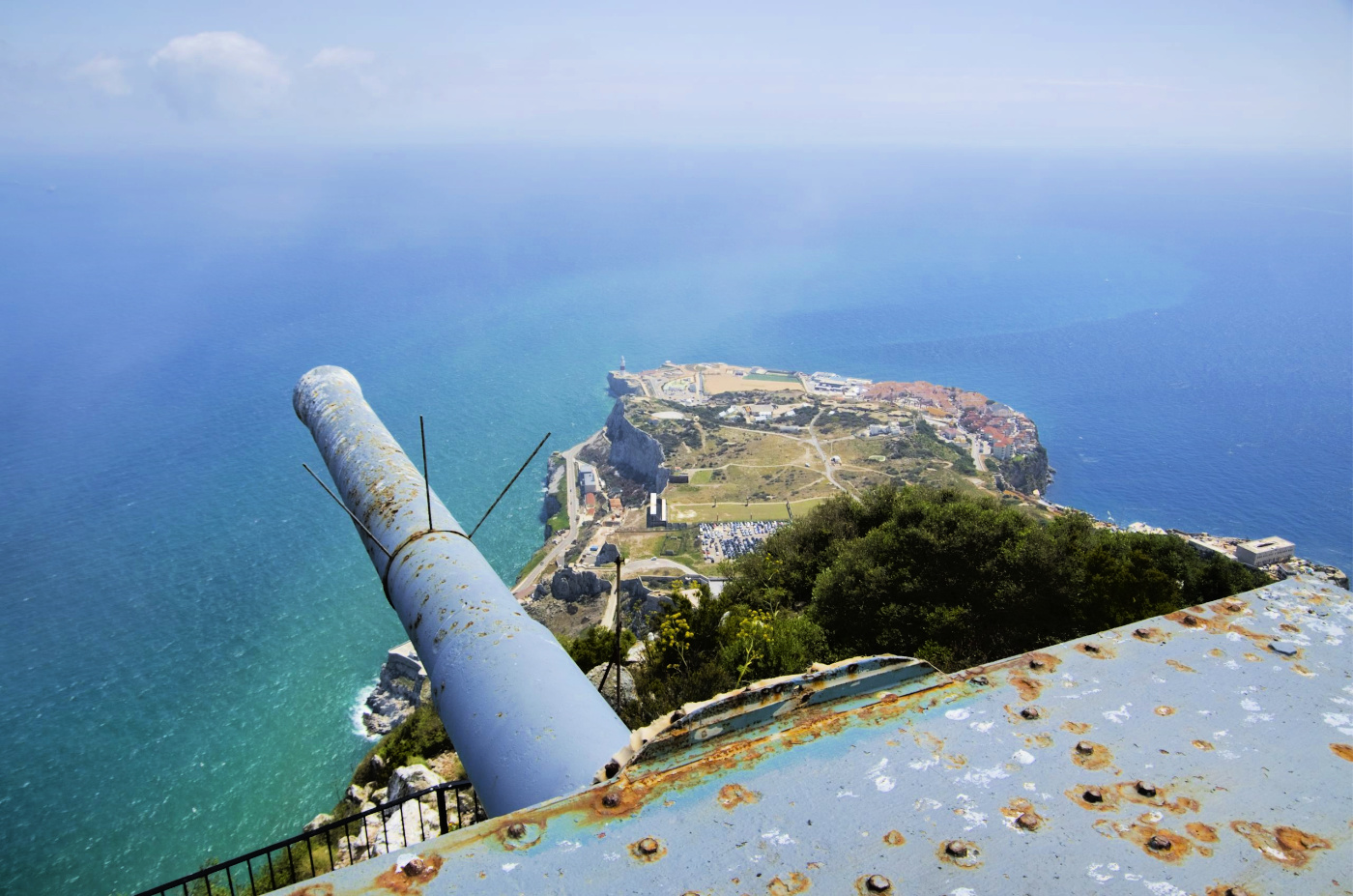
Peer Down from O’Hara’s Battery
The Nature Reserve is home not just to unique wildlife, but also some of Gibraltar’s most storied sites.
O’Hara’s Battery is the highest point in Gibraltar and worth a visit for that reason alone. Once upon a time, it was the site of a watchtower built by Charles O’Hara, a former governor of Gibraltar, who believed that an observation post at such a high altitude would provide the British with a way to spy on the Spanish port of Cadiz. When construction was completed, however, no such viewpoint materialized, leading people to call the structure O’Hara’s Folly.
In 1890, the old tower was replaced with an artillery battery, which survives (in modified form) to this day. The enormous gun that tops the installation remains in place, while inside the turret is a modest but informative little exhibition on how the battery once functioned. For military enthusiasts, there is also another smaller military outpost, Lord Airey’s Battery, just a few steps away that can also be explored.
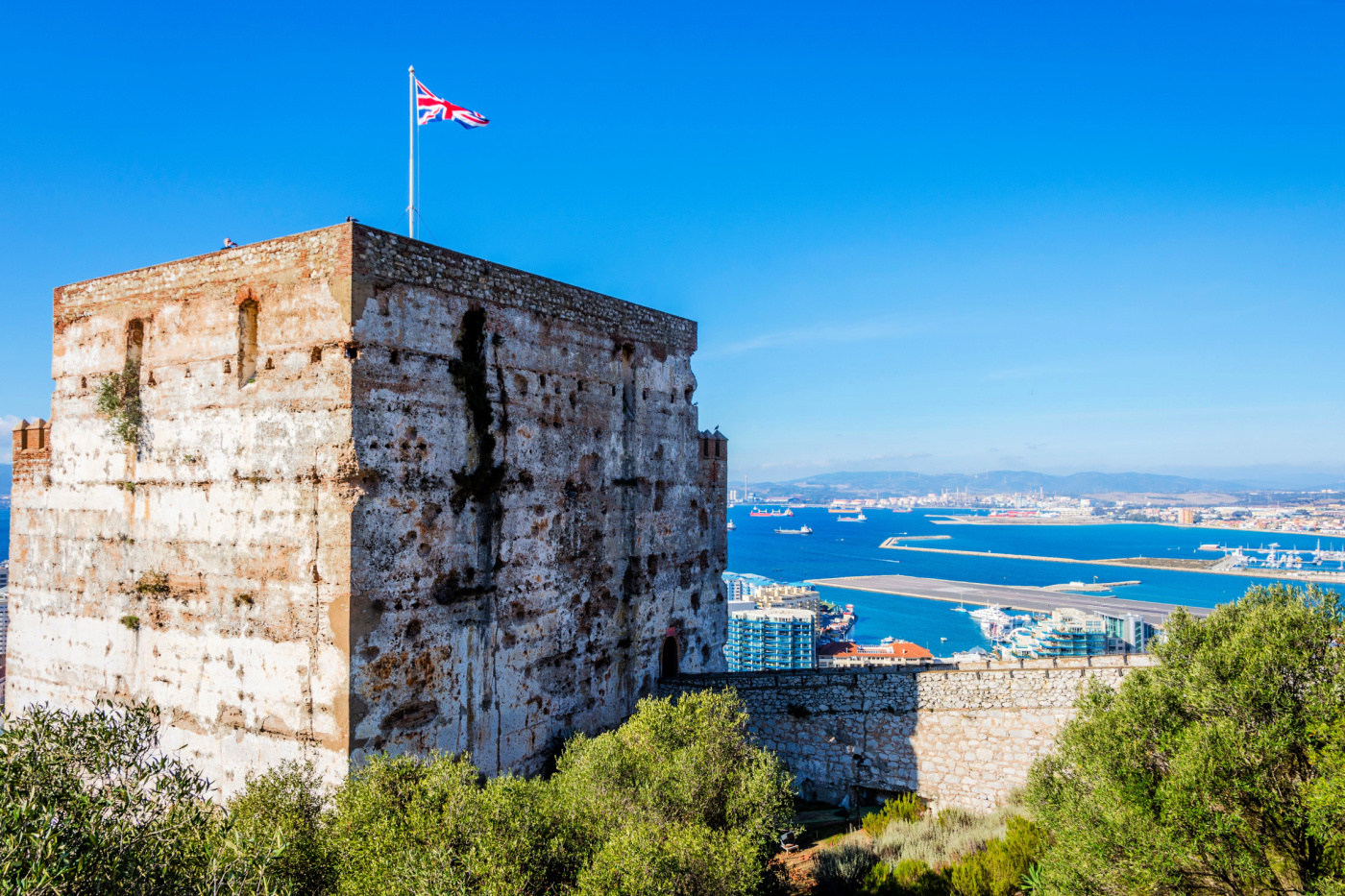
Mount the Moorish Castle
As with much of Southern Spain, Gibraltar has its own remnants of a Moorish Castle. More of a romantic ruin than an impressively preserved structure, it’s a reminder of the many centuries when the territory was ruled over by caliphates and sultanates.
While the location may have been the site of a fortification as far back as the 8th century AD, the current stonework all stems from the 14th century, after the Marinid Dynasty reconquered Gibraltar from the Spanish (there was a fair bit of back and forth over the area in the Middle Ages).
Of what remains, the Tower of Homage is the most striking building, jutting imperiously out of the Rock. It may look boxy and devoid of style, but history would suggest it is an undeniably effective defensive structure. Taking into account the many attacks launched against it and the castle more broadly since its construction, it rarely failed to repel would-be invaders – and none of the many cannon balls that struck its façade managed to knock it down.
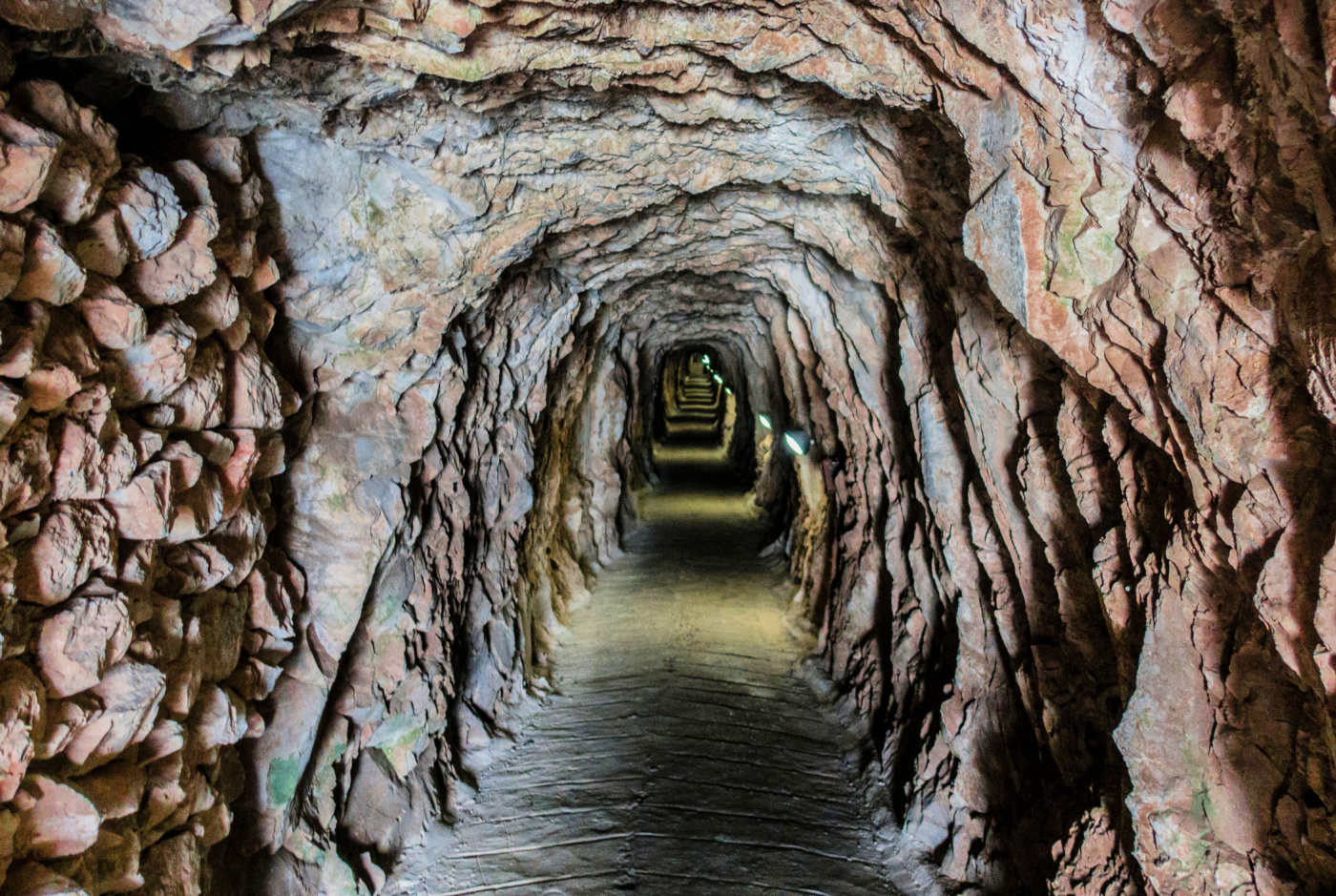
Explore the Great Siege Tunnels
War has come to the shores of Gibraltar many times in the course of human history. One of the most fascinating relics of this military past is the Great Siege Tunnels, a network of routes cutting through the interior of the Rock that were laboriously made using nothing more than sledgehammers, crowbars – and a hefty helping of gunpowder.
The tunnels get their name from the Great Siege of the area by the Spanish and French, which lasted from 1779 to 1983. Amazingly, this was the 14th siege that Gibraltar had to endure! The governor of that time wanted to position guns on a slim projection on the northern face of the rock. Military engineers suggested that the best way to do this would be to burrow tunnels. As these were being constructed, it was realized that openings along the route could also be used to mount guns.
Today, you can wander along these tunnels, which contain exhibits explaining the history alongside retired cannons and slightly disturbing life-size waxworks of soldiers in period-accurate uniforms. Interestingly, the cannon hatches in the northern chambers overlook, rather ominously, the modern airport runway.
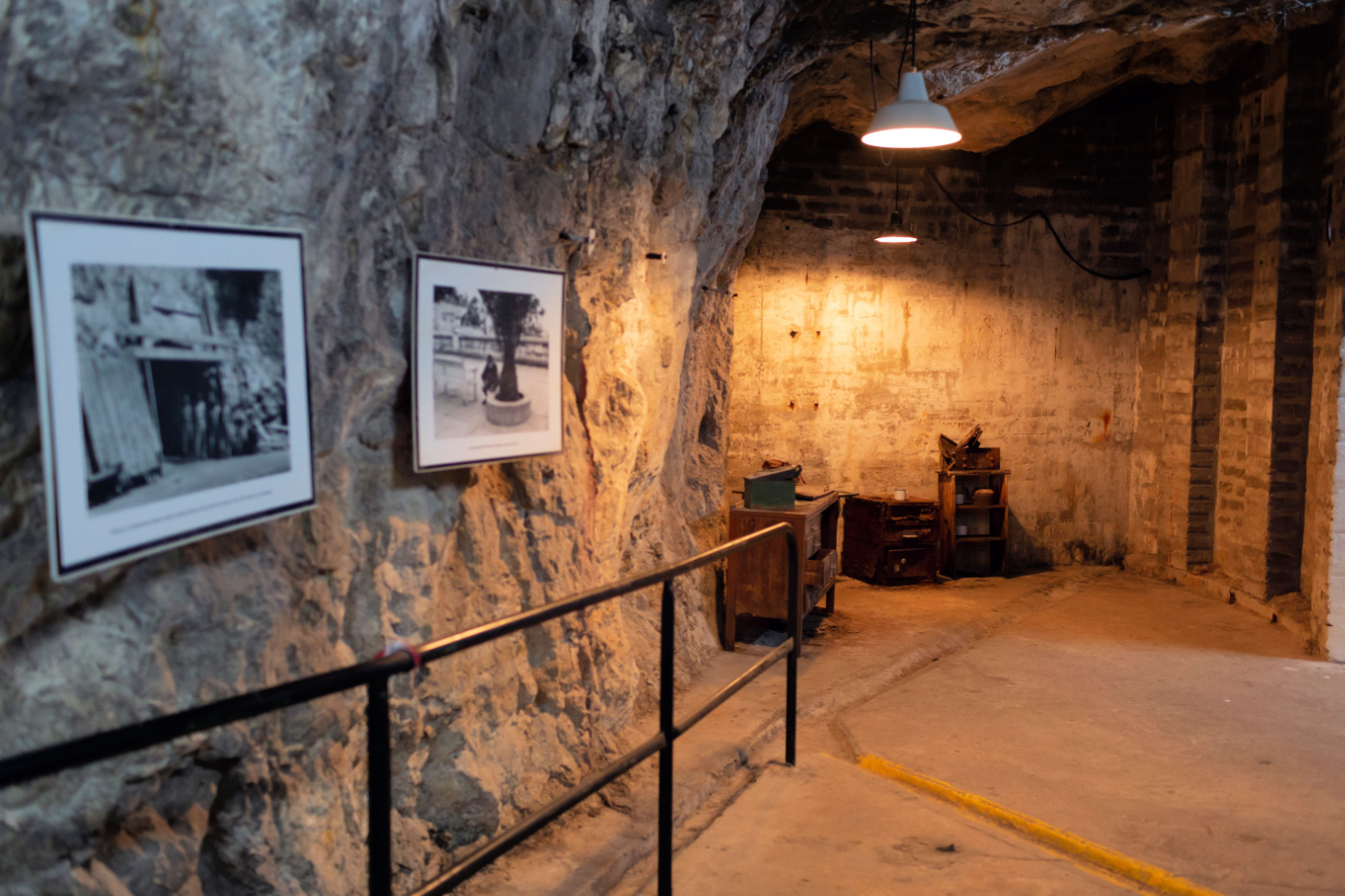
Feel History Come Alive in the WWII Tunnels
The Great Siege Tunnels were thought such an ingenious idea by later generations that they were expanded during World War II by Winston Churchill. These were designed to enable the British soldiers to evade aerial bombardment and remain a thorn in the side of the Axis powers. They did in fact enable troops to avoid sustaining casualties during the course of several bombing runs.
As you wander through the World War II Tunnels today, it’s noticeable how much more extensive they are than the original ones. In fact, they total a grand 34 miles – especially remarkable considering Gibraltar itself is only three miles long. As the audio guide (supplied at the entrance) will tell you, the tunnels were built to form a sort of underground city, complete with power generating station, a water distillation plant, a hospital and a bakery, as well as barracks for the men and ammunition stores.
In a pinch, the garrison of 16,000 men was said to have been supplied with another food that they could survive 16 months before being forced to surrender. Fortunately, this was never put the to the test.
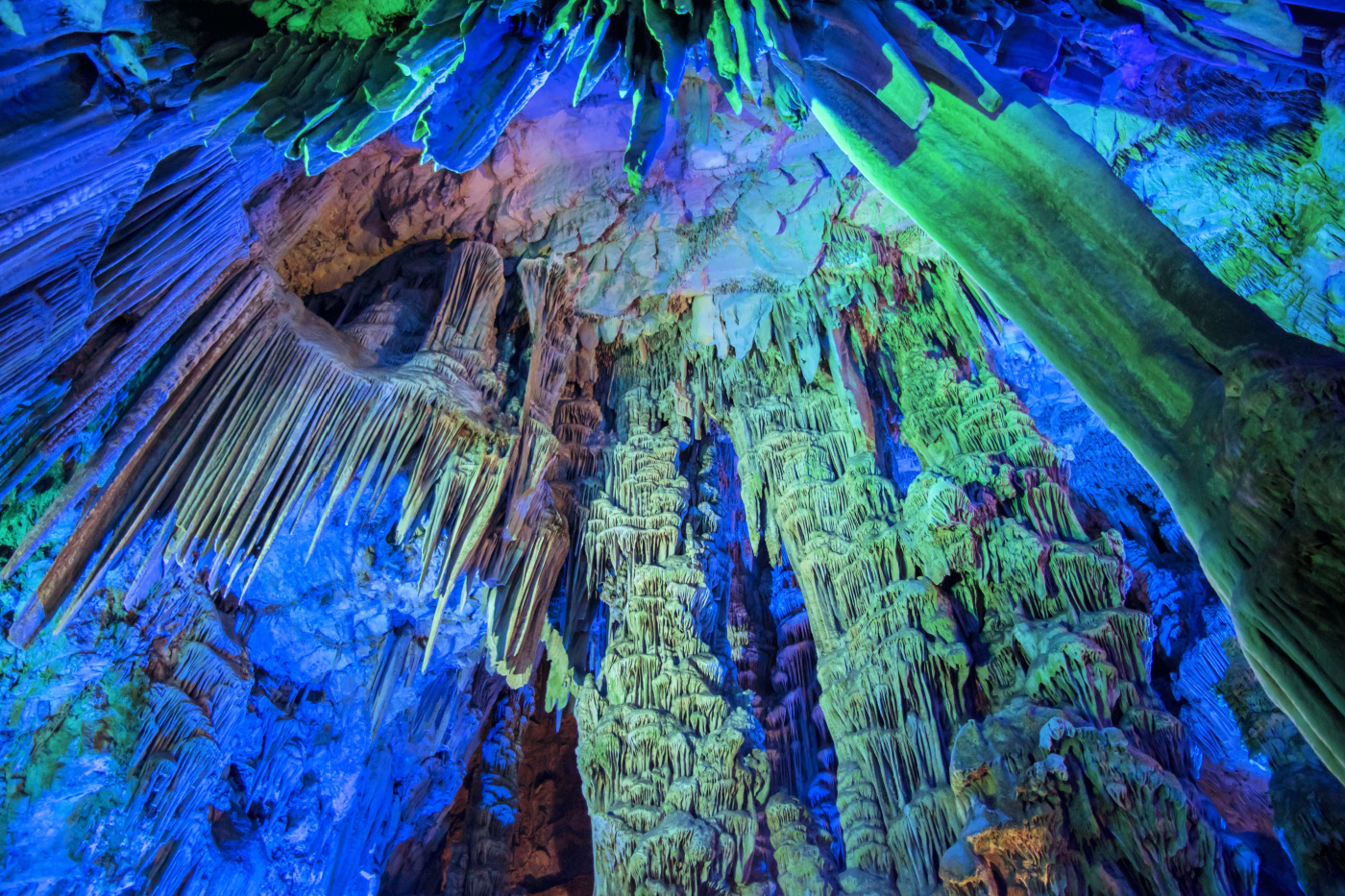
Enter a Prehistoric World in St. Michael’s Cave
St. Michael’s Cave is the most developed of the limestone caves you can visit in Gibraltar. Another constituent of the Nature Reserve’s bountiful attractions, its interior is filled with dramatic stalagmites and stalactites, creating an otherworldly landscape formed by thousands of years of rainwater.
Remember those mysterious macaques from earlier? Well, some legends claim that St. Michael’s Cave once former part of a subterranean passage linking Gibraltar to Morocco, and that’s how the monkeys arrived. Less fancifully but arguably more impressively, archaeological finds suggest that this cave may have been used by humanity as far back as 40,000 years ago.
Today, the site has been zhuzhed up with a gaudy show of multicolored lights and atmospheric music that has been rather grandly dubbed ‘The Awakening.’ If you want a more natural experience (and have the time), it’s worth forking out for the appointment-only tour of Lower St. Michael’s Cave, which has been left largely untouched – barring some lighting to help you avoid stepping into the miniature lagoon.
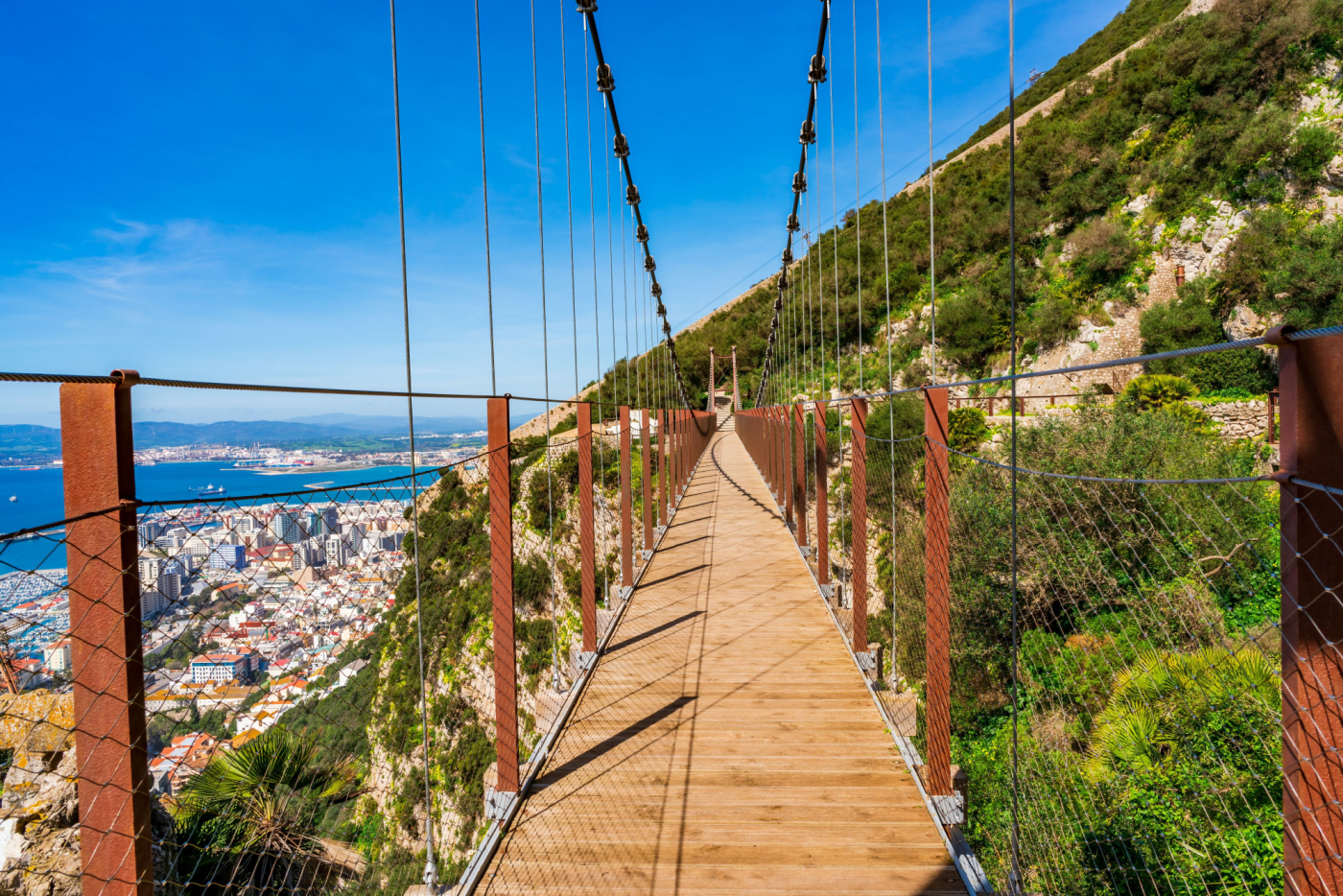
Test Your Nerve on the Windsor Suspension Bridge
Crossing the Windsor Suspension Bridge is easily one of the most terrifying things to do in Gibraltar. While it might not satisfy hardened adrenalin junkies, most people will probably agree with us that the drop of 50 meters is plenty far enough, especially if you have the daring to gaze down over the edge of the webbed sides at the gorge below.
The bridge was built in 2016 as part of several projects designed to provide some modern appeal to the Rock and attract those looking for more excitement as part of their exploration of Gibraltar’s natural wonders.
There will be plenty of time to contemplate just how far away the ground looks as you traverse the 71 meters of wooden planks. There will also be plenty of time to take in the beautiful views of the town, the marina and the natural environs that surround you on all sides. Truly, this is one of the most spectacular ways to experience Gibraltar.
Take on the Heights of the Skywalk
Continue your thrill seeking with a quick jaunt along the Skywalk, opened in 2018. This short walkway hangs suspended above a sheer drop down the side of the Rock, the transparent glass floor giving you a view straight to the bottom. Constructed to provide a 360-degree panorama, it’s yet another place in Gibraltar that boasts impressive views.
If that all sounds rather terrifying, rest assured that the glass has been designed to take the weight of five Asian elephants (or, rather less poetically, 340 people), and there are strict limits on how many folks are allowed on at any one time (a mere 50). Admittedly, it’s not as exciting as the glass bridge of China’s Zhangjiajie, but worth a visit considering there’s no charge for the attraction.
Star Wars fans may also like to know that the Skywalk was opened by none other than Luke Skywalker himself, Mark Hamill.
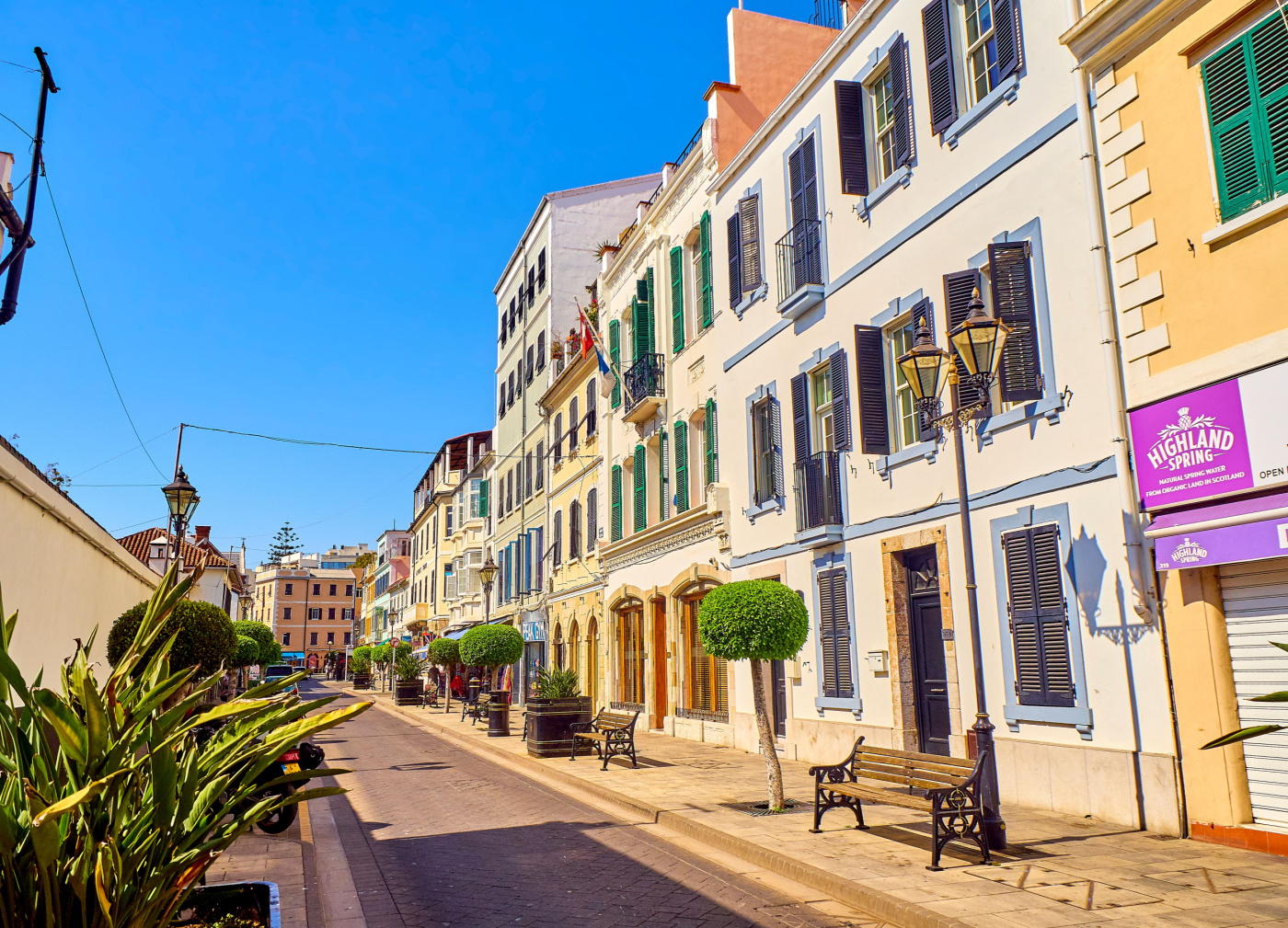
Stroll Down the Main Street of the Old Town
One of the most surreal experiences when visiting Gibraltar is wandering down the Old Town’s principal artery, Main Street. Originating in the 14th century, there’s nothing particularly remarkable about the buildings flanking the route, although there is an eclectic mix of architectural styles on show. No, what is unique about it is how very English everything seems.
Most of Main Street is taken up with the kinds of modern shops, cafes and restaurants you’d expect to find in any British town or city – but certainly not on the southern tip of Spain. Signboards advertise fried brekkies and mugs of tea at cafes are squeezed between stores like Marks & Spencer and Holland & Barrett.
Nothing sums up the confusing identity of Gibraltar better than Main Street, where, just a few steps away from Andalusia, you’ll have more luck asking for directions in English than you will in Spanish.
Don’t be afraid to venture off down the side streets to discover more of the downtown – you’ll be hard-pressed to get lost given the limited number of options!
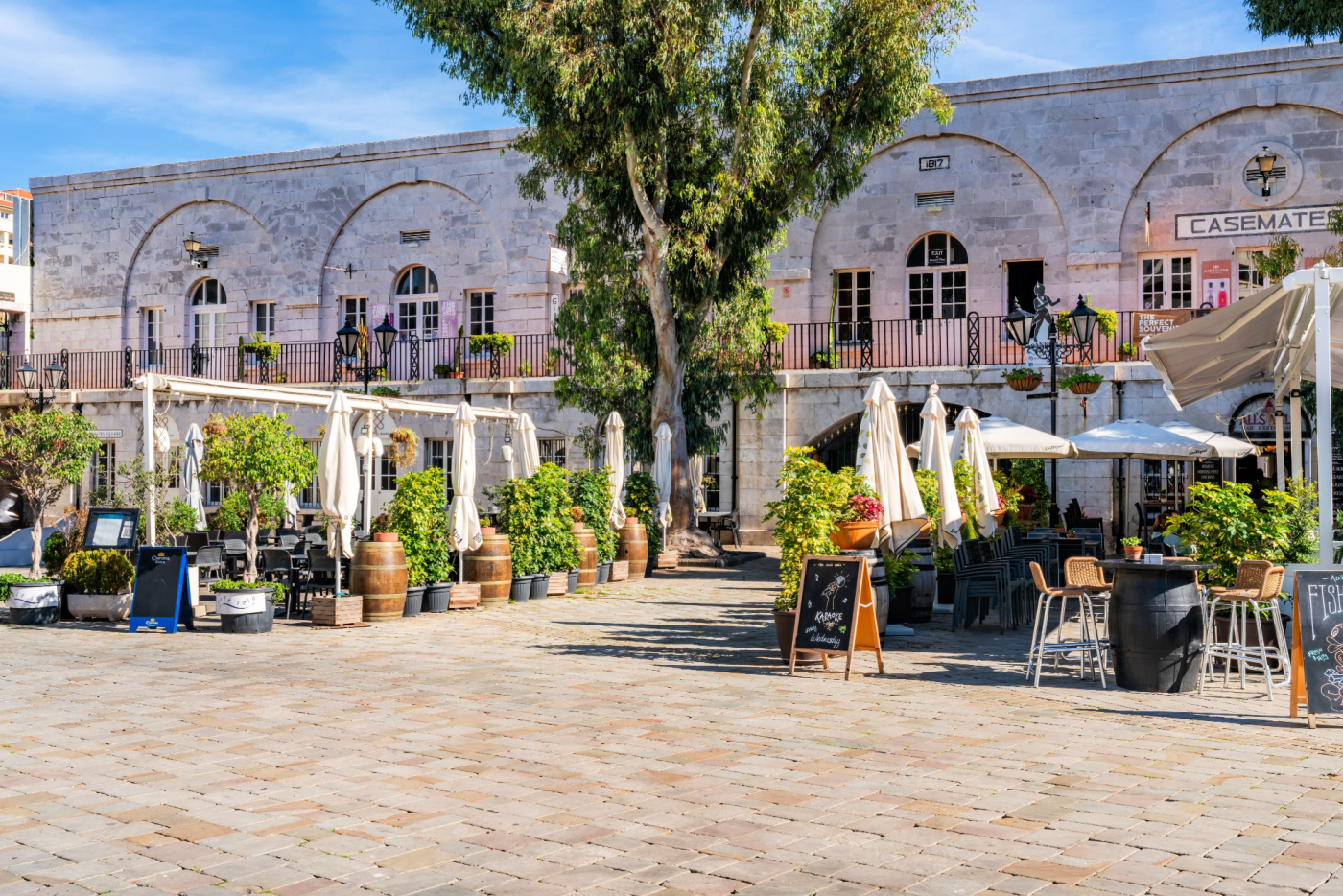
Grab a Drink and a Bite on Casemates Square
At one end of Main Street is Gibraltar’s main plaza, Grand Casemates Square, a gathering spot for many of the locals as well as visiting tourists. Once a place of execution – the last hanging in the British Overseas Territory took place here in 1864 – the space is now dominated by pubs and restaurants with spacious covered patios.
If you’re looking for a good place to take the load off for a while, there’s no better spot in Gibraltar. Relax in the sun with a pint of beer or some fish and chips (we recommend grabbing the version at Roy’s, complete with the traditional mushy peas).
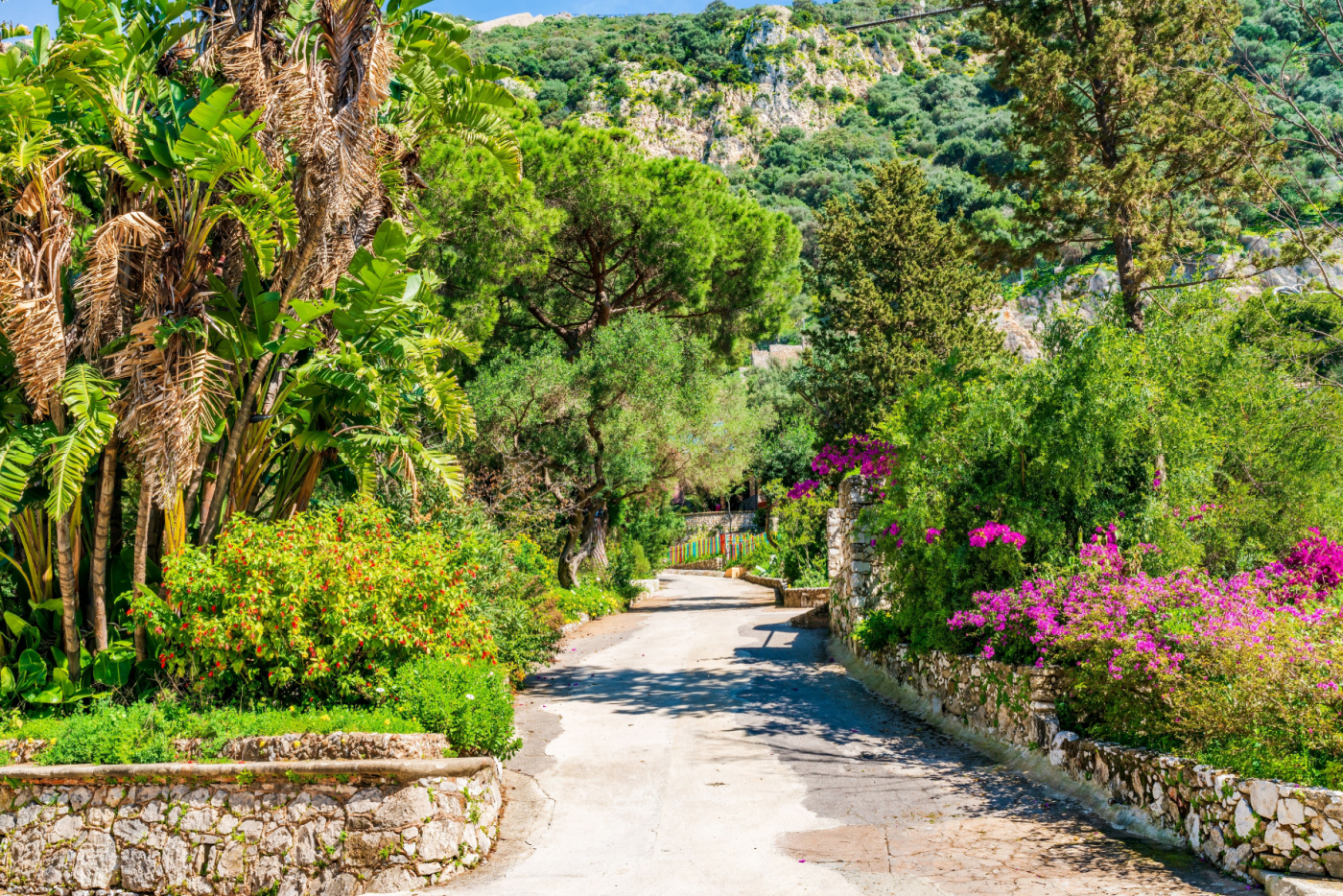
Relax and Refresh in the Alameda Gardens
If you want a calming respite after the hurly-burly, head to the Alameda Gardens for an hour. More formally known as the Gibraltar Botanical Gardens, this oasis was created in 1816 by the governor of Gibraltar at the time, George Don, who wanted somewhere the garrison (and to a lesser extent the citizenry) could relax and cool off.
While the grounds are modest, everything is well labeled and neatly partitioned into themed areas. The Dell in particular is very popular with couples taking wedding photos, the white flash of a wedding dress setting of the tendrils of greenery rather fetchingly.
If you head deeper into the gardens, you’ll come across the Alameda Wildlife Conservation Park, home to exotic animals that have either been rescued from careless owners or confiscated from traffickers. These include some adorable ring-tailed lemurs as well as marmosets, tamarins, bats, tortoises, parrots, cockatoos and iguanas.
Entry is £5 for the main Alameda Gardens, with a further £6 for the Alameda Wildlife Conservation Park.
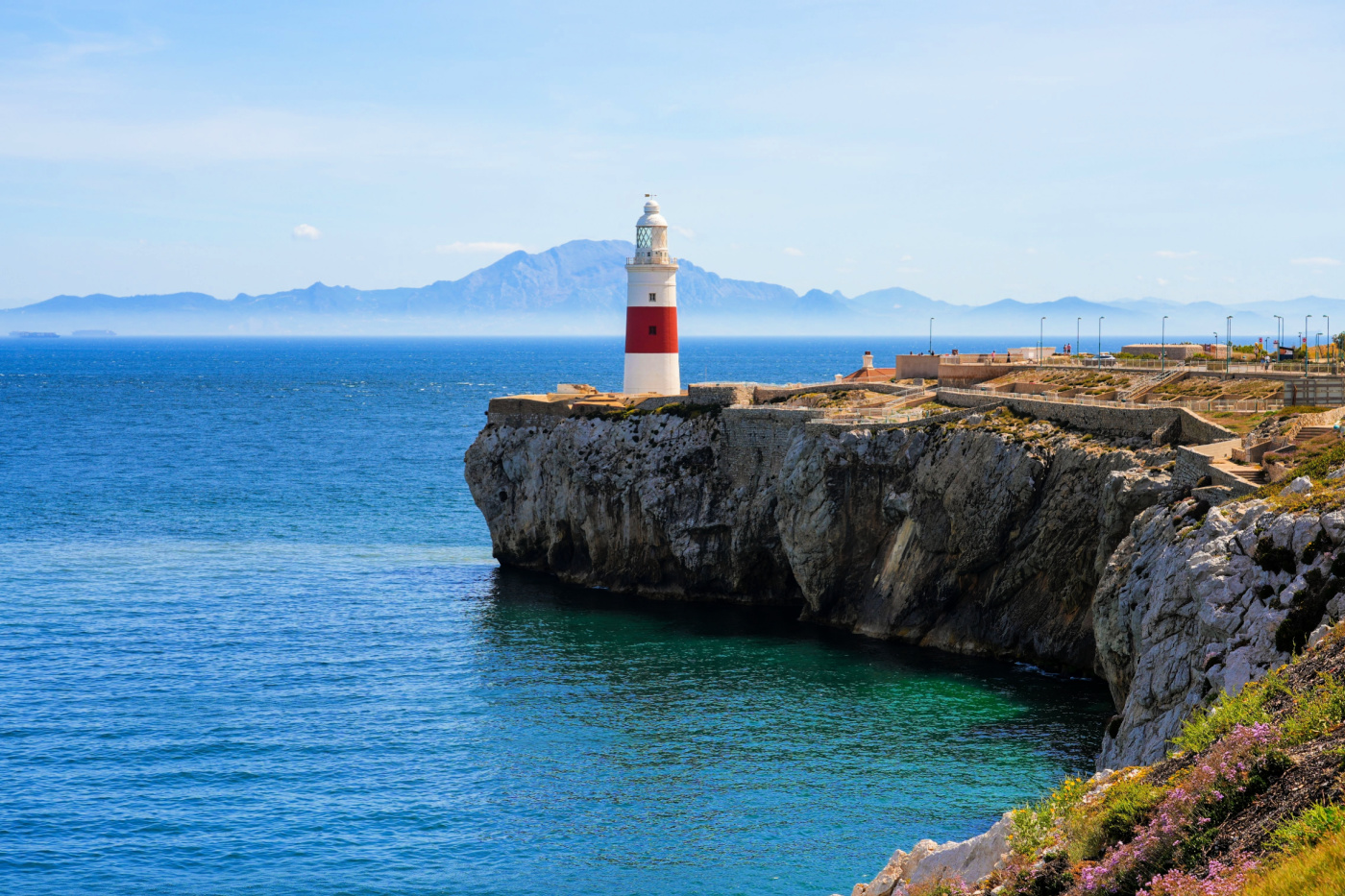
Glimpse Africa from Europa Point
At the southern tip of Gibraltar is Europa Point. While it’s located pretty far from everything else in the territory, on a clear day, it’s worth making the trip to try and catch a glimpse of Morocco (and the other Pillar of Hercules, Jebel Musa) across the sea.
The little patch of land is host to a couple of incongruous buildings. The traditional Victorian lighthouse, striped red and white, has been an attraction here since 1841, although today it is fully automated and has been updated with more modern technology.
Nearby is the gleaming white marble of Ibrahim-al-Ibrahim Mosque, a £5 million gift to the region made at the end of the 20th century by Saudi Arabia to commemorate Gibraltar’s Islamic past.

Take a Dolphin Watching Cruise
The waters around Gibraltar are a fantastic place to see dolphins all year round. As a result, there are several cruises and tour companies available that will take you out onto the waters for an hour or two to watch these playful creatures in their natural habitat.
Most tours include commentary from the ship’s crew, who are able to point out the three distinct species that thrive in these fish-rich seas: the common dolphin, the bottlenose dolphin and the striped dolphin.
Aside from the dolphins themselves, a trip out in a boat gives you a different perspective of the Rock and Gibraltar itself that you won’t get from any other angle. Kick up your feet and the let the motion of the waves send you into a relaxed reverie.
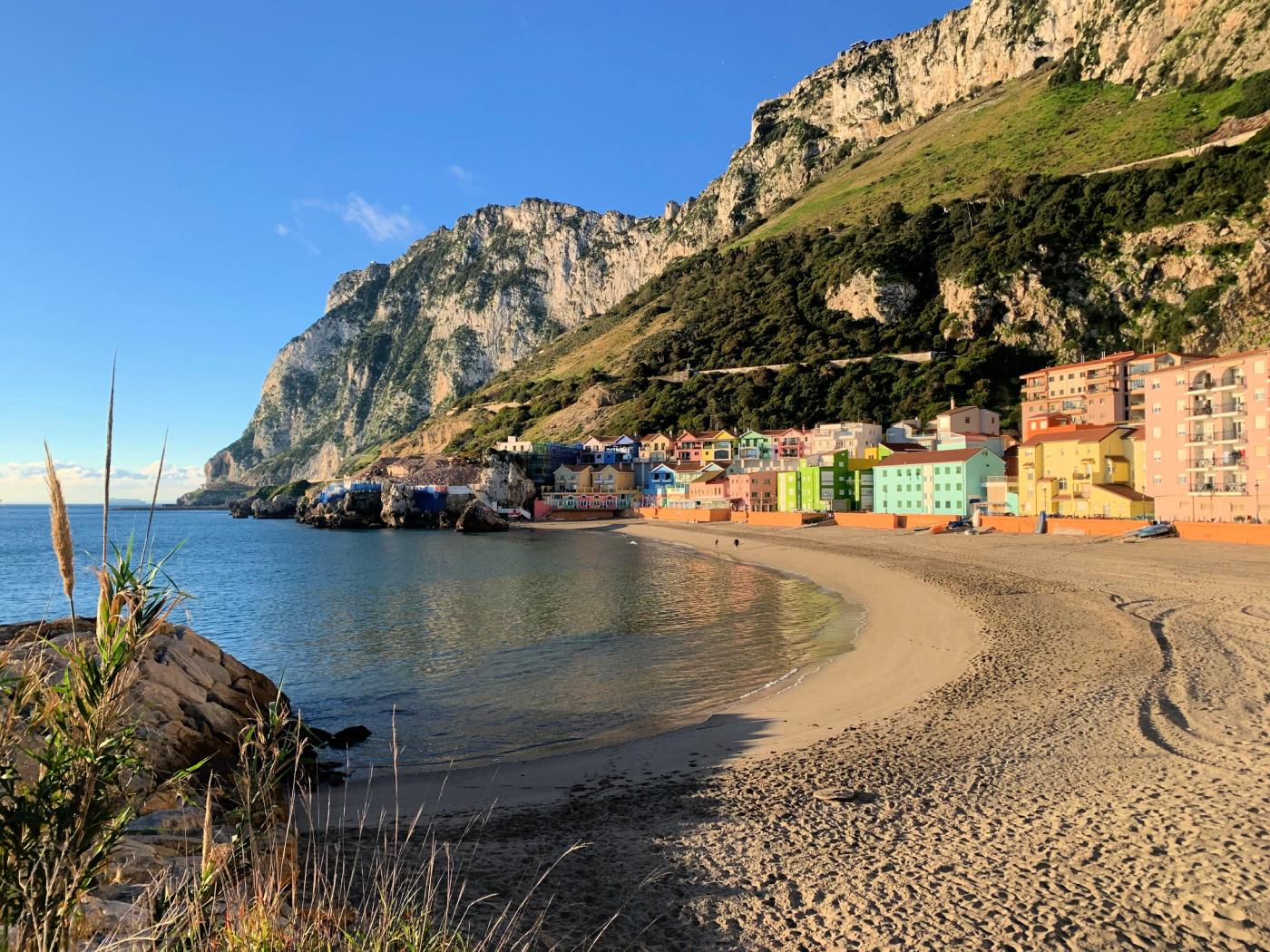
Catch Some Rays on the Beach
Gibraltar is home to some wonderful beaches, the best of which (in our opinion) our located on the lesser populated eastern side of the headland. Perhaps the most charming is Catalan Bay (La Caleta in Spanish), a sandy stretch overlooked by a traditional village of colorful houses that lend the spot a quaint air.
At one point, only licensed fishermen were allowed to live here, and many of the residences are still owned by their descendants. Space is fairly limited, so it pays to get their early and stake your spot in high season. It’s easy enough to while away a whole day, especially because there are shops and restaurants nearby for drinks and food.
Slightly further south, Sandy Bay was only restored in 2014, after its beach had been all but destroyed by erosion. It now arguably has the most fantastically soft sand of all the beaches – 50,000 tons of it, to be exact, imported all the way from the Western Sahara.
Largest of Gibraltar’s beaches is the uninventively named Eastern Beach. It is also the only one that gets sun throughout the entire day, as well as being the most easily accessible from the main town. If you’re a bit of an aviation enthusiast, you’ll have a prime view of flights taking off – but if you’re not, you might want to head somewhere else to avoid the screech of the engines.
Gibraltar National Museum
We’ve dabbled a bit in the history of Gibraltar in this post, but if you want to really get into the complex past of the region, there’s no better place to start than the Gibraltar National Museum.
Exhibits stretch all the way back to prehistoric times, documenting what is known of Neanderthal presence on the headland, before describing the later advent of Phoenician and Carthaginian traders. It’s all pretty basic, but interesting.
Our favorite experience, however, is exploring the Moorish baths, located in the basement of the museum. These restored rooms, dated to about the 14th century, have an eerie feel today, the sparse illumination bouncing off the stone walls in a slightly spooky fashion.
Entrance to the modest museum is an appropriately minor £5. However, if you opt for the £8 ticket, you can also visit the Gorham Cave Complex and Viewing Platform. To be honest, though, we wouldn’t bother, since you can’t really see much at all from the platform, though the talk by staff is informative. If you are genuinely interested in visiting Gorham (Gibraltar’s only UNESCO World Heritage Site), it’s much better to arrange for a tour so that you can actually get inside the caves.
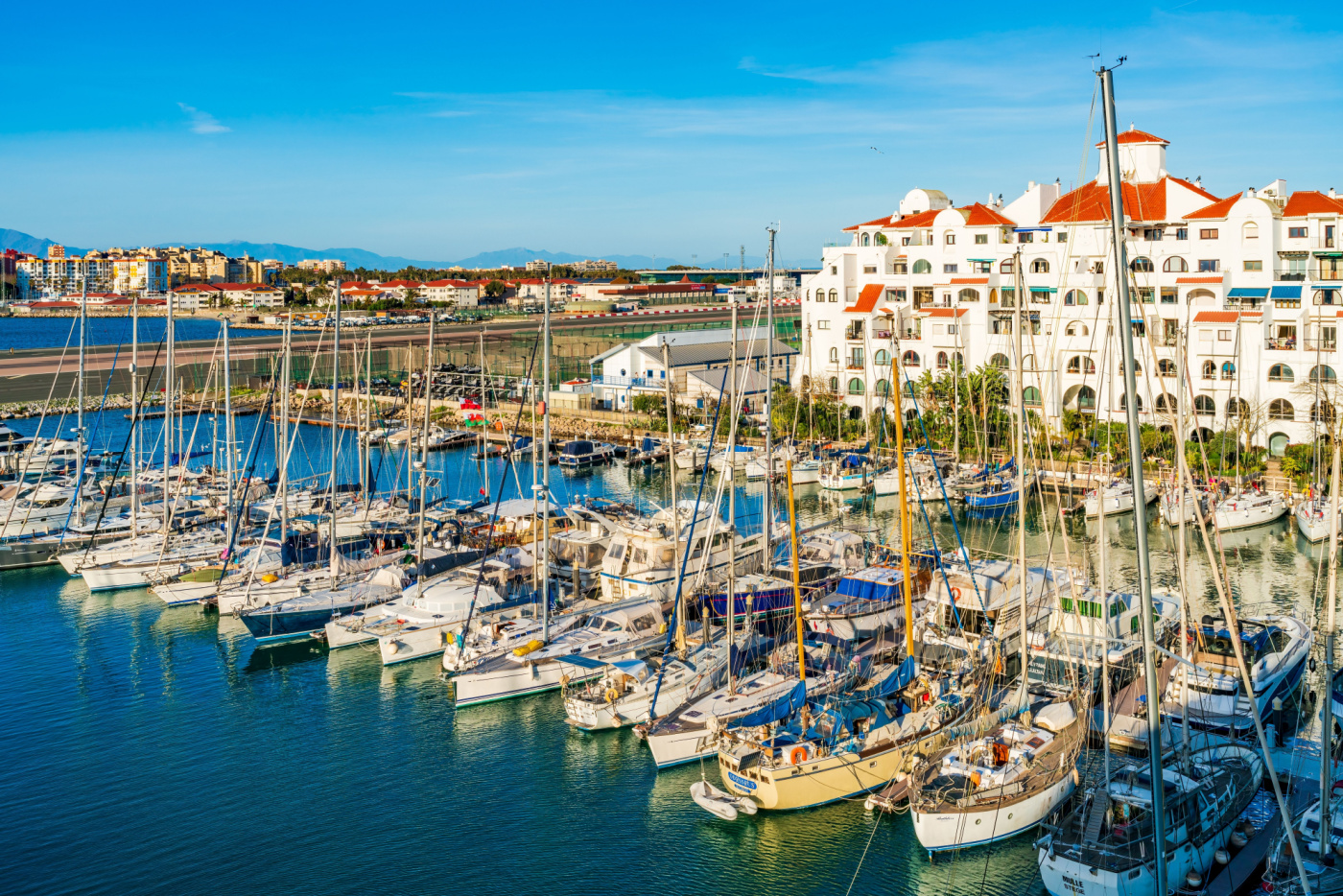
Watch the Sun Set over the Marina in Ocean Village
Ocean Village is one of the newest developments in Gibraltar, home to fancy modern apartments as well as a selection of restaurants, bars and shops. The waterfront area only recently completed development and overlooks the marina, where yachts bob up and down upon the bright blue sea.
We recommend heading here just before sunset, so you can enjoy the transition from day to night, as the sun sinks beyond the horizon and the lights from the modern buildings wink on to set everything sparkling.
For hearty platefuls of food, we really like Charlie’s Steak & Grill, which doesn’t skimp on the portions or the sauces.







No Comment